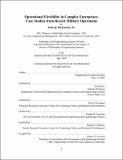Operational flexibility on complex enterprises : case studies from recent military operations
Author(s)
Dickmann, John Q
DownloadFull printable version (7.900Mb)
Other Contributors
Massachusetts Institute of Technology. Engineering Systems Division.
Advisor
Joel Moses.
Terms of use
Metadata
Show full item recordAbstract
An emerging requirement for 21st century enterprises is operational flexibility, a requirement particularly important for the U. S. Department of Defense (DoD). To achieve flexibility, most practice and research emphasizes process improvement, robust collaboration and "flattened" or "networked" organizations. Lateral alignment has also been proposed as a means to enable flexibility. Missing from these approaches is an appreciation and understanding of the role of architecture and hierarchy as well how to apply these ideas at the enterprise level of organization. The DoD has embraced information technology as one means to achieve flexibility via these methods. Within DoD the Air Force is a uniquely flexible combat arm, but it has proven particularly difficult to integrate air power at the level of inter-service (Joint) military operations in order to leverage this flexibility. Kometer (ESD Ph.D., 2005) used a complex, large-scale, interconnected, open, socio-technical (CLIOS) systems analysis to examine command and control of the Combat Air Operations System (CAOS), proposing new command and control concepts to gain flexibility. This thesis extends Kometer's research by using a qualitative architectural analysis to explore the twin ideas of hierarchy and laterality in enabling flexibility. We define lateral interactions as those within the same layer of an enterprise hierarchy. Lateral interactions enable formalized collaboration among peer entities, which can enable more operational alternatives and make these alternatives executable on more responsive timelines than possible with classic hierarchical structures. (cont.) We identify previously unexamined trends in the operational architecture of combat air operations that are related to flexibility and examine the trade-offs between flexibility and other enterprise properties. We find a pattern of increasing enterprise laterality from beginning to end of the case studies and an association between upper- and lower-echelon laterality, overall system flexibility and strategic coherence. To enrich the analytical framework, an analogous example of flexibility in the New England Patriots football team is developed and presented. We find that our architecture framework provides a rich addition to existing empirical research on combat air power and addresses difficult socio-technical analysis issues in a way that complements other approaches. We also find that traditional perspectives on flexibility, efficiency and effectiveness trade-offs are strongly dependent on hierarchical level of analysis. Our framework lays a foundation for rigorous holistic enterprise design efforts in the area of military operations and other socio-technical enterprises such as health care, disaster relief and large-scale defense acquisition.
Description
Thesis (Ph. D.)--Massachusetts Institute of Technology, Engineering Systems Division, June 2009. This electronic version was submitted by the student author. The certified thesis is available in the Institute Archives and Special Collections. "May 2009." Cataloged from student-submitted PDF version of thesis. Includes bibliographical references.
Date issued
2009Department
Massachusetts Institute of Technology. Engineering Systems DivisionPublisher
Massachusetts Institute of Technology
Keywords
Engineering Systems Division.